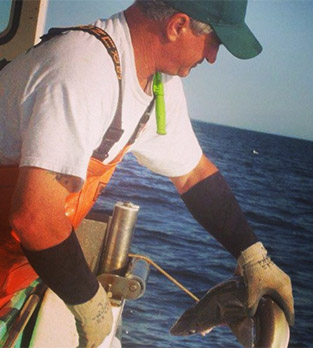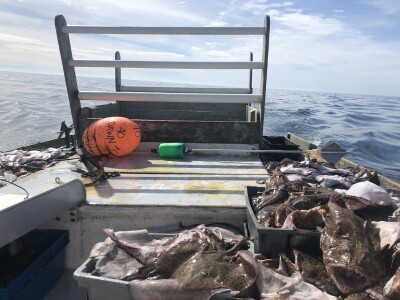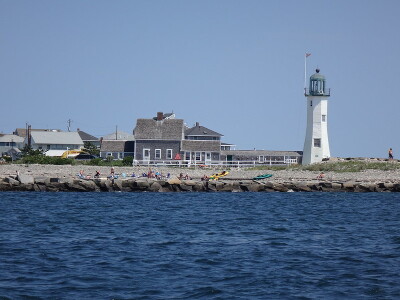John Tuttle, F/V Cuda out of Chatham, grabs a dogfish off the line. Photo courtesy Cape Cod Fishermen’s Alliance.I’ve been thinking lately about marketing seafood and whether the name of a fish really affects my likelihood of buying it. Reading about recent efforts to rebrand and market dogfish as Cape shark have brought this to mind.
At first, I wondered if changing the name of a fish was really the way to go about it. Wouldn’t it just introduce more confusion for consumers who already struggle to identify seafood and are hesitant to try new things?
The more I read about dogfish, though, the more I realize that this isn’t renaming a fish people are used to eating…it’s starting from zero.
A year ago if you’d asked me what dogfish was, I would have responded “A craft beer.” Not that I wasn’t aware it was also a fish — I vaguely remember seeing them when I went lobstering with my grandfather as a kid. Those trips were in waters not far off Cape Cod, and I thought dogfish were baby sharks. Learning that the FDA had officially approved the moniker “Cape shark” to market the fish (which is a species of shark), it made perfect sense to me.
And really, if given a choice on a menu between dogfish and Cape shark, I think I would choose Cape shark every time. It sounds mildly exotic and dangerous, not like an aquatic version of man’s best friend.
A new name is one thing, but how do you get it in front of people? Although dogfish has long enjoyed a healthy market abroad — think traditional British fish and chips — creating demand for it in the U.S. has required a thoughtful strategy.
Enter the Cape Cod Commercial Fishermen’s Alliance, which is working hard to build a stable domestic market for a sustainable and plentiful species in a fishery that has struggled following the collapse of traditional groundfish like cod.
“The fish gets exported, and it leaves fishermen — and the entire supply chain, frankly — at the mercy of foreign currency changes and economic fluctuations,” said Nancy Civetta, communications director for the Cape Cod Commercial Fishermen’s Alliance. "This is a fishery that could use some stability, and a domestic market will not only help create that stability, but at the end of the day will probably help create a better price for the fish, long term. Right now, fishermen only get 18 cents per pound."
With the help of a Salstonstall-Kennedy Grant awarded in 2014, the group has worked closely with the Gulf of Maine Research Institute and the University of New England to get the fish to chefs, promoting its mild white flesh and bonelessness.
Steve DeLeonardis, who operates restaurants in Orleans and Chatham, Mass. on the Cape began using the fish in a new menu item — a burrito called the “SharkRito” — in June. In the summer of 2015, the name got a boost courtesy of the Great White sharks that came to congregate off Cape Cod.
“We’re on the Cape and there’s been all this buzz about the Great Whites down here,” De Leonardis told the Boston Globe. “We have a younger, hip demo here that responds well to what we’re doing.”
De Leonardis offered the SharkRito only on Fridays, and by the end of the summer he was selling 20 to 30 pounds of Cape shark per week.
 “Sharck bites” made from Cape Shark debuted at UNE last fall. UNE photo.“For a lot of fishermen on Cape Cod, their bread and butter fishery was cod,” Civetta said. “There is no cod left here, and they’ve had to reinvent themselves. For a decade now, they’ve been pursuing other species like monkfish, and skate, and dogfish. Skate and dogfish are very, very popular abroad, but not here. It’s seafood Americans could embrace, if they were more aware of it, and that’s what we want to do.”
“Sharck bites” made from Cape Shark debuted at UNE last fall. UNE photo.“For a lot of fishermen on Cape Cod, their bread and butter fishery was cod,” Civetta said. “There is no cod left here, and they’ve had to reinvent themselves. For a decade now, they’ve been pursuing other species like monkfish, and skate, and dogfish. Skate and dogfish are very, very popular abroad, but not here. It’s seafood Americans could embrace, if they were more aware of it, and that’s what we want to do.”
Although the current grant to promote Cape shark domestically runs out in June, Civetta said they would pursue new funding opportunities to continue the work they’ve started, especially networking with domestic buyers who will purchase the fish in large quantities for institutions. The University of New England began trialling battered “sharck bites” made from Cape shark in dining halls last fall, an experiment extended to Southern Maine Community College through dining provider Sodexo.
So what’s in a name? A lot of hardworking fishermen and their supporters trying to adjust to changing circumstances and create demand for a fish they’ve been catching in large quantities for years. Cape shark is just one example of the ways in which people in the fishing industry are thinking critically about ecosystem management and markets — and doing something about what they learn.
Doesn’t it make you want a SharkRito?







